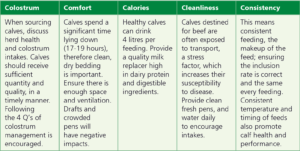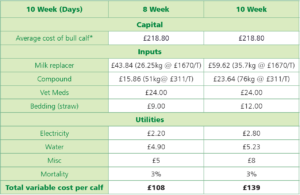Whether rearing beef calves in a suckler herd situation or artificially rearing them from the dairy sector, attention to detail and ensuring calves get the best start is fundamental to lifetime performance.
Sourcing calves: When sourcing calves, it is key to know the health status of the herd of where they are coming from. This is not only important to calf health, but it heightens the risk of bringing diseases onto the farm, which can be of particular concern if you already have other livestock on the holding. If at market or farm sale, inspection of the calves is important alongside knowing the health status of where they are from. Calves should be of good weight for their age (over 7 days old), have a dry navel and should be bright and bold; not showing any signs of ill-health.
Giving calves the best start: Whether calves are for replacement heifers or for beef, colostrum intake is fundamental to ensuring those calves have that passive immunity needed to thrive! This also applies to suckled calves; ensure they are up and sucking the dams as soon as possible! Any calves that have had difficult calving’s require extra care and attention. The preweaning phase and colostrum has a massive impact on finished beef as the time taken to get them finished all starts from this period. Research has shown that calves which have received 4L of colostrum, compared to the traditional 2L, have significantly greater growth rates (Faber et al., 2005). For most beef enterprises, daily liveweight gain (DLWG) is a key performance indicator, so sourcing calves with good colostrum management is fundamental to business performance.
This also applies to milk replacer, this phase is the most efficient period in a calf’s life and where their feed to growth conversion is at their highest, so feeding a higher plane of nutrition pre weaning can result in a higher weaned weights and DLWG!
Ensuring a market:
It is important for any business to know that there is a market for their product. For those only wanting to rear, are there units which they can then move onto? Is there a target weight they need to be? For those who are wanting to take calves all the way through, is the demand there? Speaking to local livestock auctioneers, meat processors and livestock marketing groups will help identify the markets and specifications.
The environment and feeding:
Like with rearing replacement heifers, the 5Cs; colostrum, comfort, calories, cleanliness and consistency apply and are important for calf health and productivity.

Costs:
The table shows estimated costs for 8 and 10 weeks weaning. These do not take into consideration the 1st 14 days of life. The concentration of calf milk replacer is at 150g/litre. In this example, NWF Ultramilk Blue is used. Water has been calculated at 850ml/litre and for every 1kg of compound, 4 litres of water are drank. Fresh water should always be available to calves.

Average market prices for 6–12-month stores range from £500/head to £1150/head* *Farmers Guardian average 04.06.21, breed of calf has a massive influence on price. Some continentals are fetching £441.70/calf where some black & whites are fetching £46.20/calf. Prices correct at time of print.
For more advice and information on maximising your Youngstock potential, please get in touch on 0800 756 2787.

